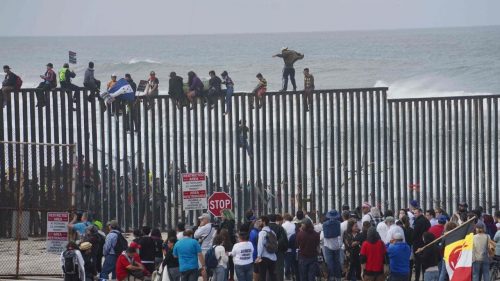Apparently we have a national emergency on the southern US border, necessitating funding for the completion of a border wall. That’s the story we are given from the Trump administration, anyway. But there seems to be some debate about the issue. Some people appear to question whether or not there is actually a national emergency, but more than that, if a wall is even necessary, or even if Trump has the authority to declare such an emergency. And, is this simply an election stunt? So many questions. So much media coverage. As is usually the case with such hyperbole, though, what is being sidelined in the process? Where should we really be looking? It would pay us to have a look at these other things, and not so much at the border wall.
Trump made his announcement about the ‘national emergency’ at 11:01 am EST in Washington. The transits to the US chart are below (bigger), which we will discuss in due course. However, we have quotes around the term ‘national emergency’ because it really is seriously questionable as to whether we have such at the southern border in the US at the moment. Instead, how about things like the crises in our foreign policy, the opioid crisis, the state of the environment, the widening wealth gap and so forth – you know, things that really are or should be considered as national emergencies?
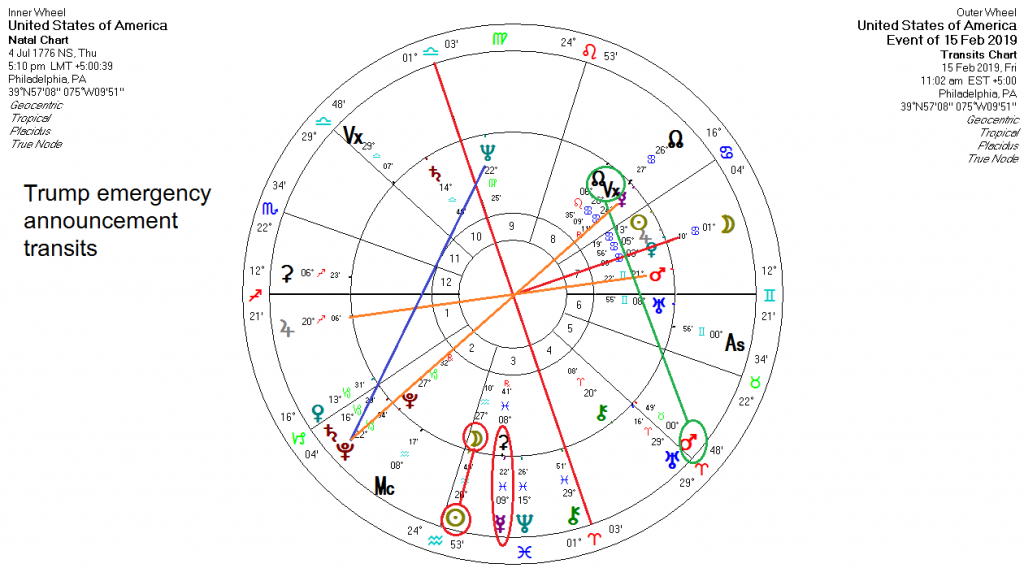
Trump’s announcement has been pointed to by some sources as provoking a constitutional crisis. Maybe, but the astrology says something quite different. In terms of real constitutional crises, like the Civil War, for instance, this little episode doesn’t even come close. Such media coverage serves to highlight the hyperbole involved with the present political climate in the US and the anti-Trump sentiments we see in many media sources. There have been several true constitutional crises in the history of the US, and we can list them here, along with links to the solar arc directions to the US chart at the time:
- The Nullification Crisis of 1832 (directions)
- The 1841 presidential succession crisis (directions)
- The secession of seven Southern states in 1861 (directions)
- The 1876 presidential election (directions)
- The 1952 steel strike (directions)
- The Watergate scandal (directions)
Astrologically, then, what would show as a constitutional crisis? Firstly, when we look at the constitution of any nation we are looking at a legal document, which is represented by the 7th house and the ruler of that house. In this case we are looking at Gemini and its ruler, Mercury. Secondly, when we look at legal challenges to such a constitution, we are looking at the 9th house of any nation, the judiciary represented by the 9th house and its ruler. In the case of the US the latter is represented by Mercury again, since Virgo rules the 9th house. But in the case of the US, further, there is a dual rulership, because Virgo is intercepted in the 9th, with the cusp of that house being in Leo, and thus we have the dual rulership of the US judiciary by both the Sun and Mercury. In nearly every case in the cited items, one or both of those factors (7th and 9th houses or rulers) were activated by directions. We should note, too, that Jupiter also rules the judiciary in general terms, with the Sun ruling leaders in general terms. And if the 1st house is activated, then the 7th house is also by reflex. Perhaps the idea is clear enough.
In answer to the question as to whether or not Trump’s attempts at a national emergency pronouncement in order to fund his border wall will lead to a constitutional crisis, let’s have a look at the current directions to the US chart, below (bigger):
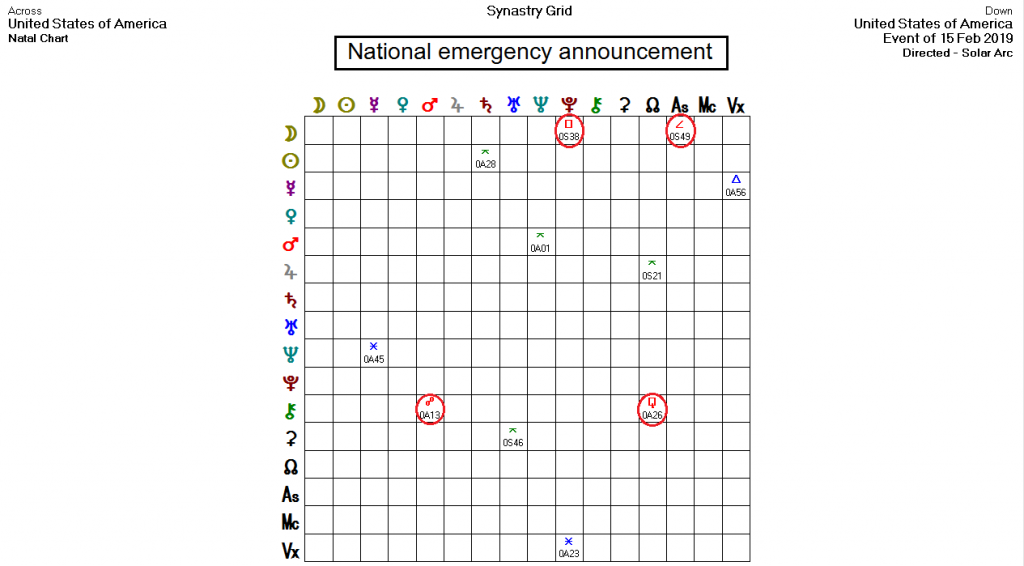
There is not much there, and what is showing is rapidly becoming passé. There was a direction of the Moon to the Ascendant, but that was exact in April of last year. If that rings a bell, it should: It was when Trump ordered the missile strikes on Syria, which could have easily resulted in a much wider conflict, and on the basis of a faked chemical weapons attack in East Ghouta. Congress, by way of the War Powers Resolution, was not doing its job. That should have been a constitutional issue. Otherwise, there was a direction of the Moon to Pluto, the latter ruling the 12th house (secret enemies of the state, covert operations and the ‘deep state’), which was really the issue at the time.
Instead, what we see with the current situation by direction to the US chart are directions by Chiron to Mars and the nodal axis. This represents the divisive nature of the current political/social climate in the US. Chiron, representing the ‘sore spots’ for the US as well as the opportunity for healing those, is instead what we see in evidence in the US at the moment. This brings up an interesting point, though: If we look back at the directions for the real constitutional crises in the US, we often see Chiron highlighted either by directions of or to that asteroid. The two starkest examples were the Civil War and the ‘52 steel strike, with difficult aspects by Pluto to Chiron. The Civil War addressed the issues of slavery, states’ rights and economics, and the steel strike was about workers’ rights. The fallout from the steel strike was that Eisenhower lost out. Workers’ rights were upheld by the Supreme Court (directed Chiron to the US Sun).
Going back to the start of this piece then, what do we see in the astrology (the transits, specifically) in Trump’s attempt to force through his wall? The main factors that stand out are the transit of Pluto opposite the US Mercury, in an effort to direct the narrative, and possibly to subvert the current political narrative. He had recently suffered defeats in Congress after his government shutdown and had to agree to greatly reduced spending on the wall. The other thing that strongly stands out is a transit of Mars approaching the midpoint of the nodal/Vertex axes. This is another midpoint which serves to shape the national outlook and with Mars approaching there the mood in the nation is decidedly combative – most of all regarding finances (2nd and 8th houses, where those axes lie).
Then, if we look at the transits to the administration at the time of the proclamation (chart below, bigger), we see transiting Neptune, Mars and Uranus all forming a hard triangle with the administration Sun, showing an ill-considered and rash/reckless decision or action. The south node is also transiting across the administration Midheaven, representing an old playbook, re: Trump’s Art of the Deal.
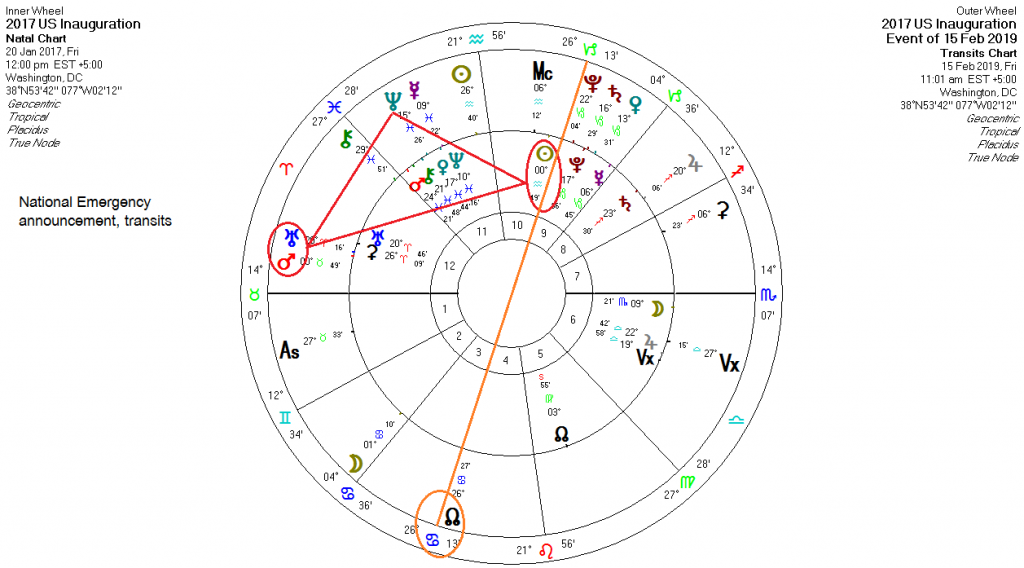
With all these points in mind, it looks as though Trump’s proclamation will come to naught. It will energize part of his voter base, for certain, but will that be enough for him? And we have still not answered the question as to whether or not the border situation truly represents a national emergency, which is central to his argument. Some people may think so, but the figures just do not bear it out.
According to US government data for 2018, (below) border captures at the Mexican border are at their lowest levels since the early 1970s. The peak year was in 2000, when there were 1,650,000 cross-border migrants, with by far the largest majority being Mexican. Levels began to drop dramatically under Obama, but had begun to drop even before that, especially since 2014 when Mexico began to intercept people before they even got to the border. There was also a sharp drop during “W’s” first term. Since 2012 there has also been a sharp spread in demographics between Mexicans and other nationalities. Now, other nationalities outnumber apprehension of Mexicans. And before we get too excited, perhaps thinking those ‘others’ are from the Middle East, the vast majority of them are from three states – El Salvador, Guatemala, and Honduras – where violent crime is high and their economies for the poorest have collapsed. The largest number of those are families, with a large number of children. Women and children now form the largest demographic of attempted border crossings.
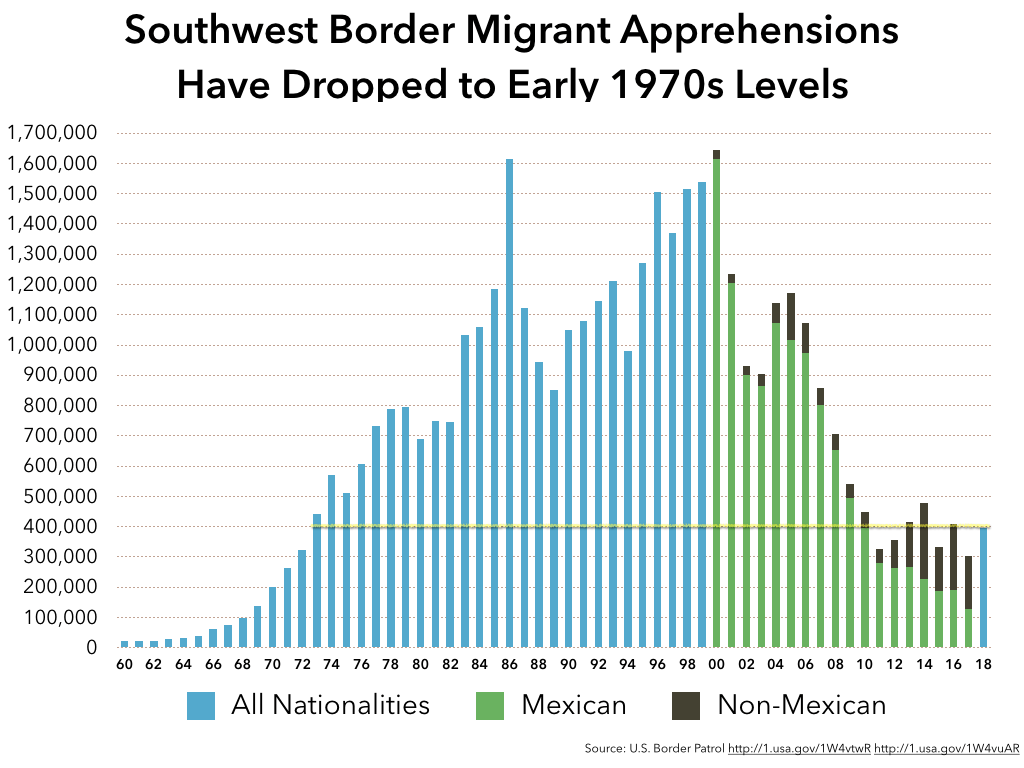
And if all that is not enough to point to why there is not a national emergency on the border, the greatest number of people apprehended at the border not from Central America are from Africa and Central Asia, not the Middle East. The largest numbers of those people from other nations – a whopping 2% of the total number of apprehensions – are from Eritrea and Bangladesh, with the next largest number from Pakistan, with most of the latter probably simply asking for asylum. And lastly, the largest number of ‘illegals’ are in the country because they have overstayed their visas, with the largest numbers of those being from Mexico and India. According to the linked site in the previous paragraph:
…Border Patrol data shows that, of all 303,916 migrants whom the agency apprehended at the U.S.-Mexico border in 2017, only 1,010—0.3 percent—came from the countries that CIS would consider to be of “special interest.” Of those, all but 222—0.07 percent—were from two countries, Pakistan and Bangladesh. Most of them were probably asking for asylum here. While we can’t ever discard the possibility that terrorists from outside our region might try to do harm by crossing the border from Mexico, there are simpler ways to them to get here, like overstaying visas. Talk of terrorists mixed in with children, families, and “migrant caravans” is irresponsible scaremongering that trivializes the threat of international terrorism.
Media paints a very different picture, though. Trump recently paid a visit to the border for a photo-op with ‘Lyin’ Ted’ Cruz (as Trump liked to call him) and Senator Cornyn in McAllen, Texas, where a border guard gave what sounded like rather alarming statistics about the number and type of illegal immigrants who were being apprehended, and in the past couple of weeks at that. Problem is, his story doesn’t gibe with the government stats. Someone is fibbing. And to wrap this up, the great majority of drug seizures by border agents are at standard ports of entry (airports and the like), not at areas where there is no wall. The stats, again, are in the region of 10 – 15% for all drug seizures being made at non-port of entry sites.
Lastly, there is another point that we might want to consider with regard to Trump’s wall, and that is why this administration appears to be so hell-bent on getting that wall in place. It would take a couple of years to do so even if funding were to be granted. It may not be simply about a campaign promise, though. Call it conspiracy if you like, but the wall may also be a wider part of what has come to be known as the Rumsfeld-Cebrowski strategy, now being directed at Latin America and more specifically at the nations of the Caribbean basin. The aim is to destabilize the region, and hence we see the antagonism of Obama and Trump toward Venezuela, Nicaragua and Cuba. If the region becomes destabilized, what would that mean for migrations of large numbers of people from the region? Would they try to go south, or to the north? It is something to think about. We’ll keep an eye on those developments. Meanwhile, the media circus around Trump and his wall will continue. For the most part, Americans don’t particularly favor putting another brick in the wall.
Featured image from NOQ Report

